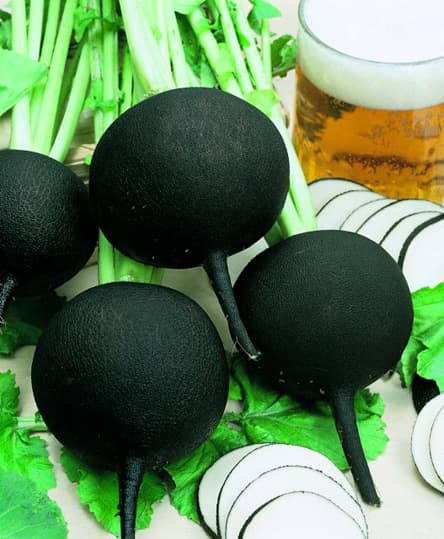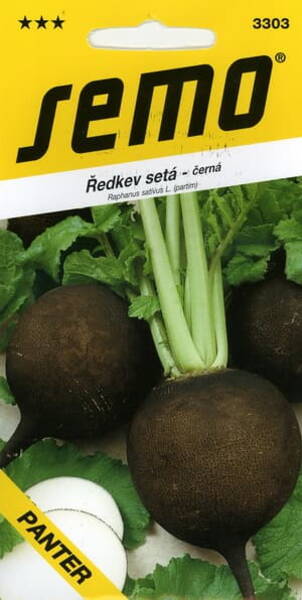Ex Tax: 51.31€
Very easy to grow. It can also be stored.
Agricultural technology.
Radish loves fertile, light-textured soils.
Sowing: From mid-June to mid-July, furrows located at a distance of 35-40 cm from each other and at a depth of 3 cm.
Seeding rate: 5-6 kg/ha.
Summer sowing depth: 1.5-2.0 cm, winter sowing: 2.5-3.0 cm.
Shoots are thinned out, leaving 15-20 cm between plants. Crops are periodically treated with a mixture of tobacco dust and ash 1:1.
Care: consists of loosening, weeding, regular watering and top dressing. Radish is fed three times throughout the growing season.
Harvest: August-October.

Eng.: Winter Radish. Suom.: Retikka. Sven.: Rättika. Bot.: Raphanus sativus L. (partim).
Winter black radish is rightly called the orderly of the human body.
The medicinal properties of black radish are easily explained by the rich content of potassium salts easily absorbed by the human body, which contribute to the excretion of toxic metabolic products from the body along with urine. And in terms of potassium content, black radish ranks first among other vegetables - 600 mg%.
Winter black radish contains salts of calcium, magnesium and iron, which have significant activity. And the phytoncides contained in root crops in large quantities have a detrimental effect on microbes and protect us from various infectious diseases. That is why radish, along with onions and garlic, is the best natural remedy for improving intestinal microflora.
In terms of vitamin content, radish is not a leader in comparison with other vegetables. However, it contains a diverse range of vitamins and a little bit of everything.
All the medicinal properties of radish and its peculiar pungent taste are due to the presence of essential oils in it, rich in sulfur-containing substances with phytoncide properties. Therefore, taking even a small amount of radish quickly stimulates the appetite. And the presence of a significant amount of fibre in radish roots contributes to increased intestinal motility.
Winter radish has not equal among vegetables in terms of the content of easily digestible compounds that contribute to the removal of toxic metabolic products from the body. In practice, for the treatment and prevention of a particular disease, it is not the root pulp that is used, but the juice obtained from it (the substances it contains have a variety of effects on the human body as a whole and on different organs).
Black radish has long been held in high esteem as a food product that enhances the secretion of digestive glands and increases appetite. To do this, finely grated radish is taken before meals with the addition of salt or honey to taste.
In folk medicine, winter radish is used for scurvy, kidney stones, gout, and atherosclerosis.
Winter radish has been especially widely used since ancient times for diseases of the lungs and bronchi with a chronic course of the disease (bronchitis, whooping cough, etc.). To do this, black radish is cut into slices and sprinkled with sugar. The juice released at the same time should be taken by adults 1 tablespoon 5-6 times a day before meals, and for children - 1 teaspoon.
In the treatment of cough in children, the medicine can be prepared in a different way. The radish should be finely chopped, put in a saucepan, sprinkle with sugar and bake in the oven over low heat for 2 hours. Then drain the liquid into a bottle and give children 2 teaspoons 3 times a day before meals and at night.
With intractable diseases of the bronchi and tuberculosis, the best effect is given by a mixture of radish juice with honey (preferably mixed herbs) in equal proportions. It is drunk 2 tablespoons 3 times a day before meals. To prepare such a medicine, traditional medicine advises cutting off the top of the root crop, making a hollow in it and filling it with honey. Then close the hole with a cut top, put it in a warm place and leave for 4 hours.
In case of bronchial asthma, it is necessary to mix in equal proportions the juice of radish, onion, beets, cranberries, lemon, aloe, honey, sugar and alcohol. Take 2 tbsp. spoon 3 times a day 30 minutes before meals.
For bronchitis and colds, gruel from finely grated radish is applied to the back and chest instead of mustard plasters. A mixture of gruel of black radish and garlic, taken in a ratio of 3: 1, is also used. Rub this mixture on your back, chest and legs before going to bed, then lie down in a warm bed and wrap yourself up well.
Radish and its juice have a diuretic and choleretic effect, stimulating the pancreas. Radish essential oils accelerate the secretion of gastric juice and improve blood circulation in the stomach and intestines. For these purposes, radish juice is diluted with water in a ratio of 1:4 and taken 0.5 cups before meals, gradually increasing the dose to 2 cups per day. It must be remembered that radish juice quickly loses its medicinal properties. Therefore, it should be consumed fresh or, in extreme cases, stored in the refrigerator.
Radish is contraindicated in diseases of the liver and kidneys, inflammatory processes in the stomach and intestines, with increased acidity of gastric juice.
Attention: to be treated with radish juice, as well as other potent drugs, you must first consult with your doctor.













